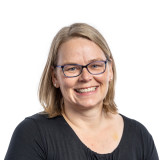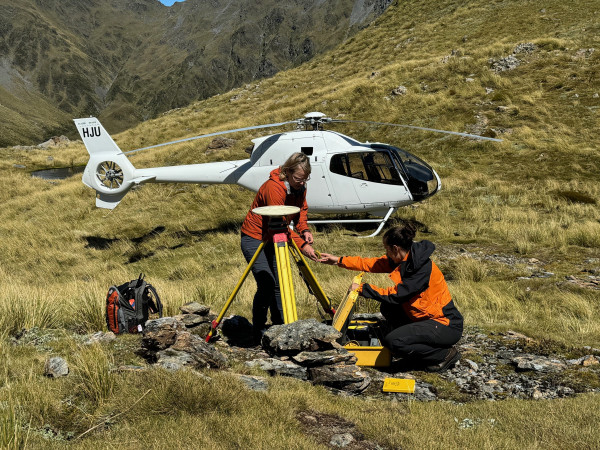Celebrating our women in science
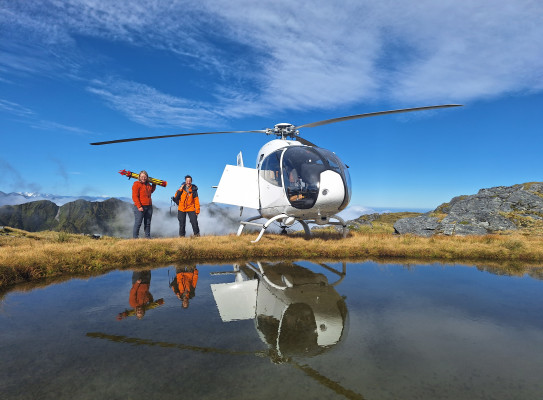
Join us as we continue to celebrate International Day of Women and Girls in Science.
Settle in for a read as we share a Q&A and incredible local and international work of two of our scientists that are helping lead action and innovation around the world.
We caught up with Cécile Ducrocq and Sigrún Hreinsdóttir who are currently based in the West Coast where they are working on a campaign focused on the Alpine Fault. This is a collaborative project between GNS Science, LINZ and University of Otago to study tectonics in New Zealand, funded by SSIF(external link) and Toitū Te Whenua Land Information New Zealand (LINZ)(external link).
Cécile Ducrocq, GNS Geodetic Technician, is working on collecting and analysing Global Navigation Satellite System (GNSS) data sets, as well as wrapping up her PhD studies at the University of Iceland specialising in GNSS and InSAR techniques to study ground deformation in southwest Iceland.
Sigrún Hreinsdóttir, GNS Senior Geodetic Scientist, applies her expertise in using GNSS geodetic measurements to study deformation of the Earth's surface.
Local work highlight – Alpine Fault
This year Cécile has taken on more responsibility and is leading an Alpine Fault project, ensuring the three teams have the necessary permits, logistics and plans in place to visit the benchmark sites. This work fills in gaps of the GeoNet network with the campaign measurements, so the GeoNet GNSS network and our measurements complement each other to study tectonics. These measurements gathered by Cécile, Sigrún and the team allow us to better understand strain accumulation on the Alpine Fault which will then inform hazard assessment in the region.
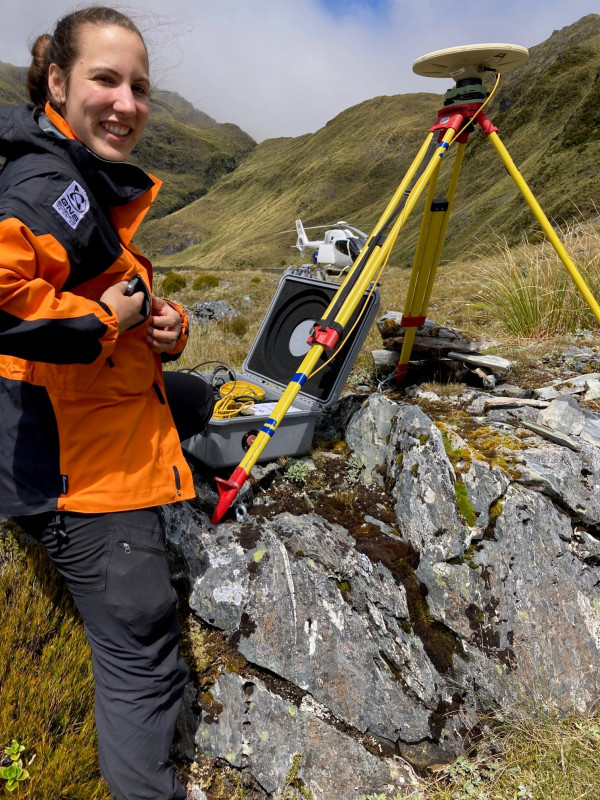
International work highlight – Icelandic Volcanic Unrest
Sigrún and Cécile have both been remotely supporting the monitoring teams during the ongoing volcanic unrest in their previous home of Iceland.
Sigrún has been developing methods to provide rapid-sub centimetre level accuracy of site positions every few hours. Collaborating with scientists at Icelandic Meteorological Office and University of Iceland, she set up analysis to provide scientists in Iceland with site positions at key stations around the volcano every four hours. This data is then used to model inflation and the propagation of the dike.
Cécile has mapped active small-scale fractures movements using InSAR over a two-year period preceding the recent eruptions. A substantial portion of these fractures were previously undetected as they were hidden by younger lavas, moss or infrastructure. This fills gaps in previous fracture maps of the southwestern peninsula. This mapping has been particularly useful for planning authorities, as some of these surface fractures have since become the focus of eruptive activity and others severely damaged infrastructure in the town of Grindavík.
This work is a collaboration with King Abdullah University of Science and Technology, Icelandic Meteorological Office and University of Iceland.
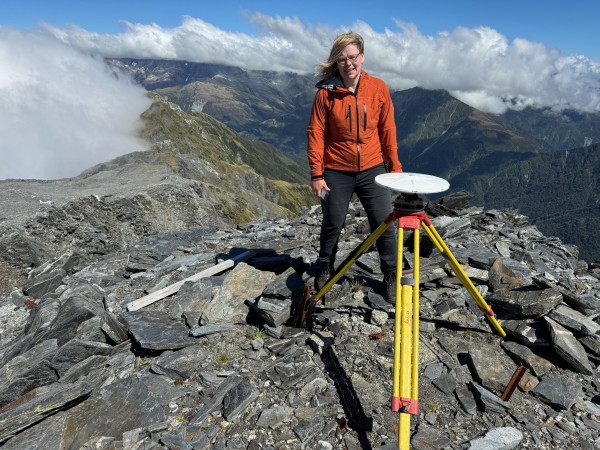
Q&A with Cécile and Sigrún
Do you have any early influences, or memories, that led to your love of science?
C: I did not have a deep love for science for most of my youth: mathematics and physics lessons seemed so theoretical and out-of-touch with the reality I was experiencing. My parents’ dream to spend a few rainy summer weeks in Iceland when I was a grumpy teenager unexpectedly revealed to my young mind that the Earth is alive, and that fascinated me. Natural sciences were therefore so much more appealing! Earth Sciences, though, were never presented as a career option during my young years. I am very grateful to one Biology-Earth Sciences teacher in high school casually saying at the start of a class that he thought Earth Sciences to be the future. This one positive opinion of the field led me to ignore all others and apply for Earth Science programs at university.
S: My parents met when they were studying in Oslo, Norway, so in a way I have always been surrounded by the love of science. My sister and I were both born while my mum was working on her degree, making me grow up to think it was just the most normal thing to pursue career in science and have a family. The way my parents viewed the world certainly influenced my way of thinking, dragging me along on skiing and hiking trips before I could even walk. My dad is a meteorologist so weather was always a big topic in our house, and we would spend several weeks every summer in the middle of Iceland (Hveravellir) where my parents would work as a release people for the manned weather station before it eventually was replaced with automatic monitoring equipment. Hveravellir is known for the hot springs, and it always felt like my second home, full of wonders.
What motivated you to pursue a career in Geophysics?
C: As most of my decision making in life, I could not choose which field in Earth Sciences interested me most, everything is interesting! But I had often been told that it is hard for women to be volcanologists or other related work, so I still believed my career and options were limited. I have been very lucky to have had several internship opportunities in various work settings and fields of study which enabled me to meet scientists interested by their research and work, which broadened my horizons, fuelled my passion in science and supported me in studying what interested me which ended being Geophysics. I still sometimes remind myself of how incredible it is that we can resolve millimetre ground motion from satellites orbiting 20,000 km above the planet! And that these subtle deformations of the ground bring valuable information on magmatic or tectonic processes that are several kilometres beneath our feet.
S: When I was in primary school, math was my favourite subject. Then I got introduced to physics in high school which I also found fascinating. I did my undergraduate degree in Physics, but halfway through my degree I started taking geology classes for fun. The first class I took was taught by professor Áslaug Geirsdóttir (a dóttir like me) and I absolutely loved it. She was my first female professor and I still remember how much I enjoyed her lectures. Then I took a class in Seismology with Professor Páll Einarsson and we had an eruption during the term (Gjálp eruption). Professor Páll took us students out of the classroom and into the lab and we started actively participating in monitoring of the eruption and later jökulhlaup (watching the seismic drums). Well, there was no turning back. I have not stopped learning since, geophysics is just full of wonders.
What led you to join GNS and move to New Zealand?
C: I always thought Aotearoa New Zealand to be interesting tectonically and for ground deformation studies in general. When my husband had the opportunity to move to New Zealand and work for GNS Science, it was too good to be true! I have been extremely lucky soon thereafter to see an advertisement for a position in my field of interest for GNS Science to study those same processes that I love.
S: It is one of the things that kind of just happened. My husband is from Australia and did not really enjoy the dark winters in Iceland. When we saw the job opening for a Geodetic Scientist in New Zealand it just felt like the perfect fit to us. New Zealand reminds us of both Alaska (where we met) and Iceland and is a bit closer to his home. We just love Aotearoa. It is a geophysical wonderland which makes me happy. The only problem is how far away we are now from Iceland.
How have you found working in New Zealand compared to Iceland?
S: The biggest difference working in New Zealand and Iceland is the vegetation. We do not have to worry about trees growing next to our GPS stations in Iceland but in New Zealand we battle to make sure our GPS receiver can see all the satellites in the sky. And well it is warmer in New Zealand.
C: Indeed, vegetation is the largest difference, as well as all the lovely native birds with a taste for plastic cables.
Any advice for people wanting to get involved in STEM, who might be reading this?
C: Do not let people’s opinion on what you should or should not be studying limit you. Focus on what interests you!
S: Find your passion. Do not compare yourself to someone else, you do you. Everyone has their strengths. You don’t have to ace every exam to become good at research.
